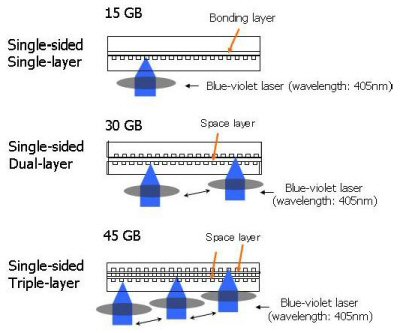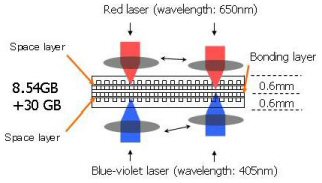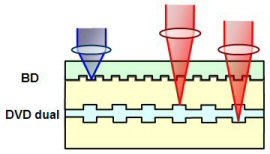Manifest Technology Blog
-- Site:
| Articles
| Galleries
| Resources
| DVI Tech
| About
| Site Map
|
Articles:
| PC Video
| Web Media
| DVD & CD
| Portable Media
| Digital Imaging
| Wireless Media
| Home Media
| Tech & Society
|
DVD & CD:
| DVD & CD Articles
| DVD Software Gallery
| High-Def DVD Gallery
| DVD Authoring Resources
|
Multi-Layer High-Def DVD Technology (9/2005)
(Blu-ray Disc and HD DVD)
by Douglas Dixon
High-Def DVD and Dual Layers
Hybrid Discs
Even More Layers
More Storage
References
How much capacity is enough? The move from floppy discs to CD was a huge jump
-- a 600X improvement (from around 1 to 650 MB). While not as larger a jump, the
6X improvement from CD to DVD (to 4.7 GB), had the benefit of maintaining form
factor compatibility with the previous generation. That same compatibility
choice has been made in moving to the next generation of high-definition
blue-laser DVD, which promises an even smaller step to another 3X to 5X capacity
improvement (15 to 25 GB per layer, for HD DVD and Blu-ray Disc).
But is 15 to 25 GB really enough for high-definition movies? Well, moving
from standard-definition to high-def requires a 6X increase in capacity (from
720 x 470 SD up to 1920 x 1080 HD). But these new formats are not just about raw
capacity; they also will using more advanced MPEG-4 or Windows Media Video
compression to reduce the video size, so it looks like the additional 3X to 5X
improvement in raw capacity should be enough.
However, many of today's movies are delivered on 8.5 GB dual-layer DVD-9
discs, and often include lots of bonus materials and data, so there's still a
need for additional space. As a result, both these format are coming to the
market supporting dual-layer formats, providing 30 to 50 GB per disc. But why
stop at two layers? Echoing hybrid formats like SACD and Dual Disc, both formats
are promising dual-format discs that provide both red-layer DVD and blue-laser
high-def DVD content, with the possibilities of multiple layers of each. And
both are discussing more layers of HD content -- 2 to 3 to 4 to maybe 8 --
promising 45 up to 100 to 200 GB per disc!
The possibilities for multi-layer high-def DVD discs were discussed at the
Next Generation DVD Summit, sponsored by the DVD Association (DVDA,
www.dvda.org) coordination with the National
Institute of Standards and Technology (NIST, www.nist.gov) in
Gaithersburg, Maryland in June 2005 (www.dvda.org/html/nist-conference.php).
The speakers included Mark Knox, technical advisor to the HD DVD Promotion
Group (www.hddvdprg.com), and Tony
Jasionowski, senior group manager at Panasonic and Blu-Ray Disc Alliance
spokesman (www.blu-raydisc.com).
Both blue-laser formats have defined base formats in both single-layer and
dual-layer versions.
The HD DVD format actually starts with today's dual-layer red-layer DVD 9
format, but with containing data stored in HD DVD format and the high-def video
compressed using the approved codecs, H.264 (MPEG-4, www.mpegif.org)
or VC1 (Microsoft Windows Media 9, www.microsoft.com/windows/windowsmedia).
Says Knox, "Since the physical format is the same as today's DVD 9, this
will be the least expensive option to provide HD content. The capacity of 8.5 GB
provides up to two hours of HD content if you use as the codecs."
The base HD DVD disc then is the HD DVD 15, with a single 15 GB
layer (or some four hours of HD content). The dual-layer HD DVD 30
format then provides 30 GB (eight hours). The specifications for both
these formats have been approved by the DVD Forum, and they will be available
later this year. The cost for single-layer discs, says Knox, is "a few
pennies more than today's single-layer DVD," while the dual-layer format is
"about 10 to 15 percent more than a DVD 9." Both formats can be
produced on the same production equipment as standard DVD. Millions of the
single-layer and a half-million dual-layer HD DVD discs have been manufactured
for testing, and have been used for demonstrations since January.

Multi-Layer HD DVD-ROM
Similarly, the Blu-ray Disc (BD) format includes both single-layer
(25 GB) and dual-layer (50 GB) formats for ROM and
recordable discs. Sony already has been selling high-end Blu-ray set-top
recorders in Japan, and is using Blu-ray for its ProData professional data disc
line and the XDCAM professional disc camcorder line. And Sony has announced that
the next PlayStation 3 (PS3) computer entertainment system will adopt the Blu-ray
Disc ROM (BD-ROM) disc format.

BD-ROM Dual / BD-ROM Quad
To support Blu-ray manufacturing, Panasonic opened a pilot production line
for Blu-ray Disc (BD-ROM) replication within its Torrance, C.A. disc
manufacturing facility. According to Jasionowski, the plant has successfully
started pilot production of 25 GB single layer spin-coated Blu-ray discs in June
2005, and Panasonic plans to spin-coat 50 GB dual layer BD-ROM discs as well.
In May 2005, the Blu-ray Disc Association reported that Singulus has
developed replication systems that will target cycle times towards three
seconds, with yields expected to exceed 90 percent for mass production. Sony has
developed a Phase Transition Mastering (PTM) process that reduces the eleven
steps currently used in DVD mastering to five for BD-ROM, requires as little as
one-fifth of the space required for DVD mastering, and permits the equipment to
be configured to allow mastering of both BD-ROM and DVD-ROM on a single system.
Technicolor is establishing a complete pilot BD disc manufacturing process by
July 2005, and Cinram has a pilot replication line that that produced demo discs
for CES 2005 and is awaiting the delivery of commercial lines.
Multi-sided and multi-layer discs also offer the possibility of offering
dual-format or "twin format" discs, hybrid formats that combine both
current standard-definition DVD and high-def DVD formats on the same disc.
"Having this disc means studios can release movies on one format,"
says Knox, "that can hold both SD and HD content. The disc can be read by
all of today's DVD players, so they can sell the discs to many consumers even if
the installed base of HD DVD players is relatively modest. This also means
consumers can use the disc on the big system in the living room as HD, or in the
bedroom, on a laptop PC or in a car DVD player with the standard side."
Two such formats have been announced for HD DVD. The first is a single-sided,
dual-layer hybrid ROM disc with one layer of each format. Announced in
December 2004 by Memory-Tech and Toshiba, the disc contains both an upper DVD
5 layer (4.7 GB) and a lower HD DVD 15 layer (15 GB) . "This has
been approved by the DVD Forum," says Knox, "but since most of today's
DVDs are DVD 9, the studios were not so excited about it."
The second hybrid disc is a double-sided, dual-layer hybrid ROM disc,
with one side containing dual-layer HD DVD 30 (30 GB), bonded to the
second DVD 9 side (8.5 GB). It was announced by Toshiba in May 2005 at
Media-Tech, and the draft specification was approved by the DVD Forum in June.

Double-Sized HD DVD-ROM / DVD-ROM
Hybrid Disc
Memory-Tech has stated that these formats can be produced on existing
manufacturing lines, which can manufacture both HD DVD and DVD discs.
Manufacturing costs for the single-sided dual-layer discs will be comparable
with that of single-sided dual-layer DVD-ROM or HD DVD-ROM discs, and the cost
for the double-sided format, says Knox, "is only a little more than today's
DVD 18."
The Blu-ray camp also has been pursuing increase capacity with multi-layer
and hybrid disc formats. While the HD DVD announcements have focused on ROM
formats for replicated discs, Blu-ray has been exploring increasing capacity for
recordable formats. The announced Blu-ray formats also are all single-sided,
even with hybrid DVD-9 layers, leaving room for a label on the other side and
simplifying consumer usage.
In December 2004, JVC announced a triple-layer combo Blu-ray / DVD ROM
format combining an outside Blu-ray disc (BD) layer (25 GB) and an inner
dual-layer DVD 9 (8.5 GB), for a total capacity of 33.5 GB.

BD-ROM (25GB) + DVD dual (8.5GB)
The format uses a high-performance reflective film that reflects the blue
laser used for Blu-ray, but is transparent to the red laser used for
conventional DVD players. By using double-faced substrate molding with a BD
layer on one side and one of the DVD layers on the other side, JVC reports it is
possible to fabricate Blu-ray / DVD combo ROM discs with approximately the same
efficiency as conventional Blu-ray ROMs.
In addition, JVC reported that it was working on a four-layer combo ROM
disc combining dual layers of both Blu-ray (50 GB) and DVD
(8.5 GB), for a total capacity of 58.5 GB storage.
Or for the most capacity, just pile on more high-capacity layers. In May
2005, Toshiba announced a triple-layer HD DVD disc at Media-Tech. The HD
DVD 45 has a capacity of 45 GB (12 hours). The draft specification for the
format has been submitted to the DVD Forum, and should be approved "later
this year," says Knox.
Knox reports that triple-layer demo material should be available in the
summer, and that existing players can read the format, requiring only a firmware
change. The discs could be available in 2005, he says, "although the very
beginning of 2006 is more likely for volume production."
As described by Toshiba, the triple-layer discs are produced by back-to-back
bonding of a 0.6mm-thick dual-layer disc and a single-layer 0.6mm disc. The
single-layer disc is produced first, using the same process as HD DVD-ROM. Next,
the second layer is formed on the first layer using a one-time polycarbonate
stamper, the same process used for the double-sided dual-layer DVD-18 disc.
Finally, the single-layer 0.6mm disc is bonded to the dual-layer disc, using
standard technology.
"The manufacturing process is similar to today's DVD 14," says
Knox, "but needs a little more precision since the bonding layer is in the
optical path. There are four additional process steps compared to DVD 9, so this
is the most expensive option, about 50% - 60% more than DVD 9. Frankly a lot of
studios do not see the advantage of 45 GB capacity, as very few films need that
much space. They also believe multiple discs are better in convincing consumers
to spend the money they need to get for multiple movies or many TV series
episodes.
Meanwhile, for Blu-ray, in June 2005, TDK announced the development of a
prototype four-layer single-sided recordable Blu-ray Disc with 100 GB
capacity, capable of storing 9 hours of HD video compressed at 24 Mbps. The disc
also can record at a data rate of 72 Mbps, double the 36Mbps rate of current
Blue-ray.
Sony and the Blu-ray camp also have demonstrated 8-layer discs in a
laboratory environment, for a whopping 200 GB capacity on a single side.
This all sounds wonderful, but is it really possible to pile on layers? Andy
Parsons, senior vice president of product development for Pioneer USA, offers
his perspective. On the one hand, the Blu-ray design closer to the surface has
advantages for multiple layer discs: "When you talk about a .1 mm cover
layer," he says, "it is much easier to produce more layers simply
because you are not trying to focus the beam through such a thick layer of
plastic material."
On the other hand, developing new formats requires both new engineering and
cost-efficient manufacturing. "Eight layers is feasible," says
Parsons, "but is it practical? We really don't know yet, because the
manufacturing process will be different than dual layer, and is that going to be
cost-effective?" Of course, he adds, "When DVD first shipped,
everybody has said that dual layer was impractical, nobody was going to be able
to do it, it was going to be too expensive. But it happened, and the price to
make dual layer now is close to the price for single layer in quantities."
The other issue is backward compatibility. "You need to ask whether
existing players will be guaranteed to play multiple layer discs," says
Parsons. "It's not just the disk; it's not going to be as trivial as a
firmware update, the tolerances are just so tight." In addition, new
formats will not be successful if they come late to a market that already has a
huge installed base. "If we can get them to market fairly quickly, even
after the products are introduced," he says, "then they can be
viable."
So here we go again -- yet another DVD format war, this time over blue-laser
formats, again threatening to confuse consumers and slow the development of a
new market. And yet the competition that this battle has fostered seems to be
paying huge dividends in the rapid development of improved technology, including
hard coat surfaces to protect discs and these multi-multi-layer disc formats --
and offering spin-off improvements for red-laser discs as well. By the time this
all shakes out, the original capacity bump promised from moving to blue-laser
DVD may well have been swamped by the bonus of extra layers.
Next Generation DVD Summit, June 2005
www.dvda.org/html/nist-conference.php
DVD Association (DVDA)
www.dvda.org
National Institute of Standards and Technology (NIST)
www.nist.gov
HD DVD Promotion Group
www.hddvdprg.com
Blu-ray Disc (BD) Association
www.blu-raydisc.com
MPEG Industry Forum - MPEG-4 AVC / H.264
www.mpegif.org
Microsoft - Windows Media Video (WMV)
www.microsoft.com/windows/windowsmedia
|
